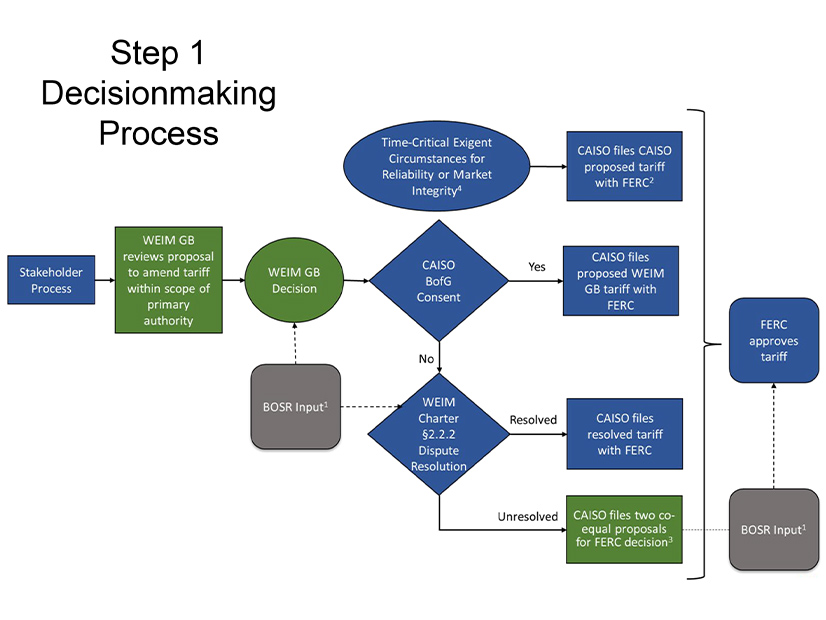
Backers of the West-Wide Governance Pathways Initiative will move quickly on a proposal to alter the governance of CAISO’s Western Energy Imbalance Market (WEIM) and Extended Day-Ahead Market (EDAM) after voting to approve the plan May 31.
The initiative’s Launch Committee unanimously endorsed step 1 of the “stepwise” proposal the group issued in April. The proposal calls for CAISO to revise the WEIM charter to elevate the oversight position of the market’s Governing Body over WEIM/EDAM matters to “primary” authority, rather than the “joint” authority it currently shares with the ISO’s Board of Governors. (See Western RTO Group Floats Independence Plan for EDAM, WEIM.)
“We’re thrilled to be able to move forward with step 1 and start to engage with … CAISO in a different way,” committee Co-Chair Kathleen Staks, executive director of Western Freedom, said after the vote.
The Launch Committee now will submit step 1 of the proposal to CAISO Board Chair Jan Schori and WEIM Governing Body Chair Andrew Campbell to kick off a stakeholder process at the ISO this month.
Pathways backers anticipate CAISO will hold an initial public stakeholder call — with the Launch Committee presenting — in mid-June. That would be followed by a three-week comment period, a committee response period and a public meeting for a joint decision by the board and Governing Body in late July or early August.
“Let me start by really thanking the Launch Committee for taking up the concept that the regulators had put forward last summer, fleshing it out and producing such an astonishing work product,” Oregon Public Utility Commissioner Letha Tawney said.
Tawney was among the group of Western state energy officials who launched the Pathways Initiative last July to increase the potential for creating a single day-ahead electricity market for the region that expressly includes California and leans on the technical capabilities of CAISO.
Arizona Corporation Commissioner Kevin Thompson, another initial supporter, commended the Launch Committee’s progress despite conflicts that arose at a previous private meeting of the committee in Phoenix.
“There was some tension there in the room a little bit here and there,” Thompson said, “but to see where the stakeholders have moved the conversation to get us toward independent governance, and giving prior primary authority to the EIM as the governing board, is a step in the right direction that gets us away from the joint authority and starts moving us really closer towards independent governance.”
The Pathways Initiative’s final proposal included a handful of changes from the original version, including expanding the responsibility of the Governing Body to respect both state and “local” policies in its decisions and highlighting the existing right of the body to institute a governance review process with the ISO board in the event of a mass withdrawal of EDAM entities from the market.
The proposal also clarified the workings of the dual filing — or “jump ball” — process that would occur in the event the CAISO board disagrees with a tariff filing approved by the Governing Body and decides to submit a parallel filing with FERC.
Next Steps and Phases
The Launch Committee also voted to continue developing step 2 of the proposal, which will seek to transfer governance of the WEIM — and its associated future EDAM — to an independent “regional organization” (RO) that the Pathways group expects to establish next year.
Step 2 poses greater challenges than the first step because it requires convincing the California legislature to pass a bill authorizing CAISO to transfer its authority over a large part of its market to the RO. While the Launch Committee itself will not be participating in those efforts, many of its members will be in their capacities as individual organizations with interests in the change.
Launch Committee member Spencer Gray, executive director of the Northwest & Intermountain Power Producers Coalition, said step 2 also must address the “core tension” between the two options being considered for the structure of the RO, which relates to “the degree of institutional independence of the regional organization and the financial liability and responsibility that comes along with institutional independence.”
Gray pointed to the series of “work streams” the Launch Committee has identified for its Phase II work plan, which focuses largely on issues embedded in step 2. The committee has appointed two leads to deal with each stream, which include:
-
- exploring the stakeholder process for the RO, including examining sector-based approaches and how to frame policies;
- dealing with CAISO-related issues;
- analyzing the existing CAISO tariff, which could entail identifying the functions of a balancing authority under a new market arrangement;
- addressing public interest issues, including considering the evolution of the WEIM’s Body of State Regulators; and
- addressing RO formation and governance, which would range from incorporation to board nomination to securing funding sources.
Committee member Lisa Tormoen Hickey, a senior regulatory attorney with Interwest Energy Alliance, told meeting participants the Pathways Initiative will need to secure about $450,000 in funding for its Phase II activities through the end of the year. Those activities will include additional legal review for RO options, proposing an RO stakeholder process, making a final step 2 recommendation, and gathering and publishing stakeholder feedback on the recommendation.
She said the committee estimates an additional $636,000 will be needed to complete Phase III activities, which will include establishing an RO “formation” committee, developing tariff amendments and bylaws, retaining a placement firm for selecting a board and management team, and monitoring California legislative and CAISO actions.



